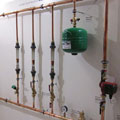
Figure 1. Caleffi demonstrates its
pressure-independent balancing valves vs. manual balancing valves. All photos
by John Siegenthaler
This past March, I was fortunate enough to spend four days in halls 6 through 11 of the International Sanitation and Heating Expo, known to most as simplyISH. This event returns to fairgrounds in Frankfurt, Germany, every two years. Most hydronics professionals consider ISH as this planet’s pre-eminent event for viewing the latest in heating and plumbing technology.
This year’s show drew more than 200,000 attendees, making it more than three times larger than the AHR Expo held each year by ASHRAE. I walked countless miles over the course of the four days, and my focus was only on the heating and cooling aspects of this show.
The European heating market continues a pervasive commitment to low energy use, reduced emissions and environmental stewardship. This theme was evident at nearly every booth. Here are some of the highlights:
Caleffi was demonstrating its pressure independent balancing valves with a simple working display. A simple working display consisting of parallel piping paths, each with a flow meter, and either a manually set balancing valve or PIBV was there for visitors to experiment with (seeFigure 1). I tried the demo myself, and quickly found those PIBVs were rock solid in holding their calibrated flow rates as the flow in other parallel circuits were varied or completely turned off. I suspect such products will enjoy a growing market now that they’re available in North America.
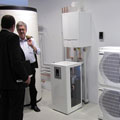
Figure 2. Schuco displays its air-to-water heat
pump/wall-hung boiler combi-system.
Combi-Systems Abound
Besides their usual offering of wall-hung condensing boilers, the “Big 3” heat-source providers Viessmann, Buderus and Vaillant were all showing well thought-out combinations of heat pumps with other heat sources such as pellet-fired boilers, solar thermal subsystems, and even micro-combined heat and power units (MCHP).Europeans have a flare for elegant industrial design. It’s common to see devices such as boilers or heat pumps housed in cabinets that give little clue to their internal workings.
It’s evidentair-to-waterheat pumps are now a major part of the heat pump market in Europe. Some manufacturers were claiming coefficient-of-performance ratings as high as 4.0 with air-source heat pumps (I’m sure under ideal conditions).
Most of these combi-systems featured a storage tank, known in Europe as a “thermal accumulator.” The high thermal mass of this tank serves as a moderator between the intermittent heat input from solar collectors, solid fuel boilers, or off-peak electricity, and a highly zoned distribution system.
Figure 2shows a setup by Schuco. The device on the right is the outdoor unit of an air-to-water heat pump. It was piped to the central control module seen in the lower middle of the photo. This module connects to the wall-hung boiler and a generously sized thermal accumulator tank seen at the far left. The central unit manages heat input from either the heat pump or boiler, heat exchange with the buffer tank and zone control. The fit and finish of these products are superb. It’s easy to visualize them neatly integrated into the laundry area of a European flat.
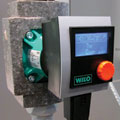
Figure 3. Wilo shows its Stratos PICO circulator.
Major Changes Ahead
Wilo was showing its Stratos PICO circulators (Figure 3). This is its flagship high-efficiency circulator for single- and two-family housing in Europe over the next few years. The smaller PICO model tops out at 20 watts power draw at full speed and can operate as low as 3 watts electrical input at minimum speed. To put this in perspective, the full-speed power requirement of this circulator is less than 10% of the power drawn by circulators that simply push water through the heat exchangers of some North American mod/con boilers.This product will meet a very stringent European circulator efficiency standard set to go into effect in two stages (Jan. 1, 2013, and Aug. 1, 2015). After the 2013 date, it will be illegal to sell standard PSC-based wet-rotor pumps in Europe. It appears what we know as the standard wet-rotor circulator with permanent split-capacitor motor is soon to disappear from new European installations. I asked about this circulator coming to North America. While I didn’t get a no, the answer suggested it’s not likely anytime soon.
Lowara (a division of ITT) was also showing its new “Auto” and “Vario” circulators, which will be available in the United States later this year through Bell & Gossett. The Auto circulator operates in proportional differential pressure mode. The Vario circulator has a dial for setting its speed over a wide range. Both circulators use high-efficiency ECM motors and are controlled by microprocessors. Such circulators could be likened to computers. With a change in firmware, they can take on “multiple personalities.” This allows the potential for them to work in a wide variety of specialized applications, such as drainback solar systems, geothermal heat pump systems and as variable-speed injection pumps. Watch for this increased versatility from a variety of manufacturers in the near future.
Well-Grounded
Several manufacturers displayed geothermal manifolds and manifold “pits.” Geothermal manifolds are made of engineered polymers that easily handle the pressure and temperature requirements of earth loop circuits. The manifolds are designed for significantly higher flow rates compared to manifolds for radiant panel heating systems.Manifold pits are watertight enclosures, typically made of polyethylene, designed to be buried with their access cover flush with finish grade. They have several stubs of HDPE tubing welded through their sidewalls. Installers simply heat-fuse HDPE earth loop circuits to these stub outs. Internally, they contain a large-diameter manifold with individual flow setting and isolation valves for each circuit. The access cover is fully gasketed to make the unit watertight.
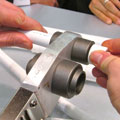
Figure
4. Multitubo Systems shows its socket fusion of PE-RT composite tubing and
fittings.
Tubing For Every Need
Hall 6 at ISH has two floor levels dedicated to displays of piping. Although it is still possible to find copper tubing on display, it’s obvious that polymer tubing (PEX, PEX-AL-PEX, PP-R, and PE-RT) is now the dominant material for hydronic distribution systems as well as domestic water.Uponor was showing large-diameter (nominal 4-inch) composite PEX-AL-PEX tubing joined using stainless steel press fittings.
One of my more interesting finds was the German company Multitubo Systems. It introduced a heat-fusible PE-RT (polyethylene, raised temperature) composite tube and fitting system. The composite (PERT-AL-PERT) piping is rated for 10 bars (147 psi) pressure and 95º C (203º F) temperature. PE-RT is not a crosslinked polymer. Unlike PEX, it can be re-melted and reshaped. This allows the tubing and fittings to be joined by socket fusion (see Figure 4 on Page 11).
The inside of the fitting and outer surface of the tube are heated using a simple electrically powered tool, pulled apart and immediately pressed straight together for a permanent bond. I was able to try this myself and can vouch that it’s pretty easy. I see this offering as a simple and low-cost way to permanently bond together pieces of tubing for longer circuits without reliance on mechanical couplings. Word is that it’s likely to find its way to North America soon.
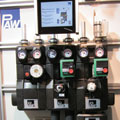
Figure 5. PAW GmbH shows its pre-piped mixing modules and header.
Pre-Piped Offerings
Many companies, such as PAW (Pommerening Armaturenwerk), were showing various mixing and zoning modules. These assemblies typically combine a hydraulic separator with a manifold. The latter can accept several preassembled modules having individually controlled mixing valves and a circulator. Such products have been available for several years. The difference is that some now sport the latest high-efficiency circulators (seeFigure 5).A Twist On TRVs
Danfoss, Honeywell and IVAR were among companies showing wireless/remotely controlled radiator valves. Viessmann even had a boiler that could wirelessly communicate with battery-powered valve actuators. Each radiator valve actuator receives a signal from a central wall-mounted display unit.From what I could gather, there are new regulations in Italy, and perhaps other parts of Europe, that require setback capability on radiator valves. While I’m sure these products work, I still cringe when thinking about changing batteries at each radiator.
Radiators
I could fill every page in this magazine with photos of the designer radiators shown at ISH, and still not cover them all. While there were certainly new artistic impressions, I didn’t see anything radically new with perhaps one exception: Kermi showed a dual water plate radiator in which all flow passes through the front panel first, and then through the rear panel. This unit offers about the same heat output as other dual water plate radiators, but reduces heat loss to the exterior wall due to lower rear surface temperatures.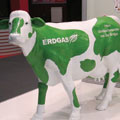
Figure 6. Gas from cows. What a novel
idea! The next step is to lace some PEX tubing through the molded bovine and
offer it as a designer radiator.
Cow Power
I’m not sure what booth space costs at ISH, but apparently one company felt compelled to buy several square meters worth to promote the idea of bio gas from farms animals (Figure 6).Viessmann also was into cow power. In a portion of what had to be the largest “booth” at ISH, it displayed a very large compost-turning device. It’s used to rotate feed stock (manure, plant matter, etc.) to generate bio gas. The bio gas is used to operate a pre-engineered combined heat and power unit that produces enough electricity and heat to sustain a small village. The company showed a schematic of the whole process from cow to thermostat.
Don’t know if you can buy the whole thing as a kit - maybe. Not sure if it will include the cows.
A Unique Experience
If you’re into hydronics or plumbing and have never been to an ISH show, I highly recommend you make the trek. The next one will be in 2013. If you have attended this show, you can surely relate to some of the novel hardware shown here.I’ve had opportunity to visit several ISH shows, as well as other European heating and plumbing trade shows over the last few years. Ultimately, I’ve concluded that these events show different products aimed at markets very different from those in North America. All the technology on display could be produced and sold in the United States, if and when energy prices (think $9 per gallon for unleaded gas) and cultural mind-sets (think environmentalism as a quasi religion) occur over here. We’re obviously not there yet, nor am I suggesting that we should be.
The North American hydronics industry can always learn from what’s on display at ISH. Over those four days I saw quite a few of my American colleagues doing just that. Some of what they saw will inevitably work its way into future North American product offerings. The ultimate goal remains the same: Deliver unsurpassed comfort using the fewest resources possible.

